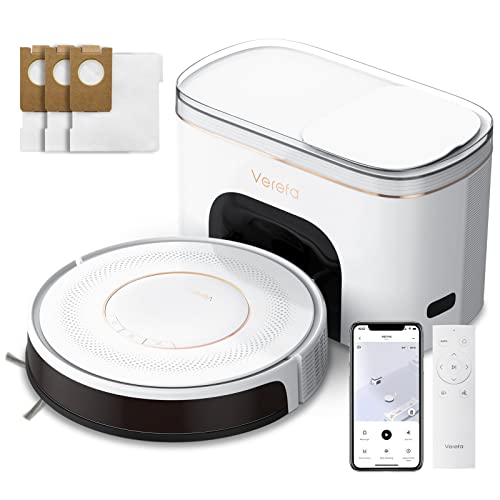The Convenience of a Self-Empting Vacuum
Although the most recent robot vacuums are remarkably quiet when in operation but emptying their trash bins can be a bit of an issue. This is particularly true if your vacuum has a self-emptying bottom.
These bases offer docks that connect to the robot vaccum and sweeps out the debris into a larger bin while charging the device. This means that the robot vacuum's dustbin no longer needs to be emptied every two or three cleaning sessions, but just once every 30 to 60 days.
1. Convenience
It might seem unprofessional to let your robot vacuum clean itself however it's actually a great convenience. The dust bins on the majority of robots require manual emptied at the end of every cleaning session. This can take a long time and hinder the robot from cleaning an entire room in a single session. A self-emptying vaccum has a base that can automatically empty the dustbin when it's full, which saves you the hassle of having to bend down to empty the little bin.
Depending on the model, self-emptying robots have a larger bin that can hold a month's worth. The process of moving dirt from the bin to its base is typically quite fast and this can make it an ideal option for those who live in big homes or have pets that shed a lot.
If you are considering a robotic vacuum that self-emptys take note that they tend to be more expensive. This is primarily due the fact that they come with a more sophisticated base with a function beyond charging your robot vacuum.
It seems obvious but it's important be aware that self-emptying bases can be quite tall. They can occupy more space than other bases, which can be a problem for smaller homes or those with little storage space. The design of some self-emptying robotic vacuums could be a source of annoyance. While it's definitely not a problem for most, it's something that might be an issue for those who are worried about the appearance of their home. The good thing is that a lot of robot vacuums that have self-emptying bases look cool, and I've had more than people who stopped me in my tracks to compliment the gorgeous piece of technology that I have in my home. Some might think this alone to justify the higher price.
2. Less Allergens
Allergens can cause problems in many homes, especially when there is a person with allergies. Using a self emptying vaccum can cut down on the amount of pet dander, dust and other allergens that are released into the air after vacuuming. You can be certain that all the nasty particles will be caught in the filter and bag instead of being released into the air. This can affect those who suffer from allergies.
If you'd like your vacuum cleaner to be more allergy-friendly, opt for one that has HEPA filtering. It also comes with an array of attachments that can be used for cleaning various surfaces. These vacuums are ideal for removing pet fur, textured crumbs, and other tough debris. This model also comes with the 25-foot cord, as well as a floor-to ceiling cleaning reach.
3. Easier Maintenance
It's a great option to let your robot vacuum empty the bin automatically and then put it in the docking station. It prevents the bin from overfilling, which could cause a clog that can make your robot smell and stop working efficiently. It's also more hygienic than having to manually empty the trash, and is probably better for those with allergies since it blocks allergens from being kicked back up into the air. The Samsung Jet Bot+ comes with a large, spacious bin that can hold more debris than other self-emptying robotic vacuums. This will help keep your floors tidy for longer. The bin is also equipped with an integrated filter that catches dirt, pet hair, and other tiny particles. This makes it easier to clean and less likely to overfill than other self-emptying robots.
4. A Shorter Time

Self-emptying robots can be a game changer for people who have a busy schedule. They allow you to complete more cleaning, without having to be physically present and empty the dustbin at the end of every cleaning session. This reduces the amount of time you're spending on chores and gives you more free time to relax or perform other activities.
Robot vacuums come with a small bin or dustbin that is used to collect the debris and dirt after each cleaning cycle. When you empty the dustbin you are exposed to the harmful substances that were released into the air. You may need to clean it by hand before you are able to use it again. The solution to this problem was made available in 2018 when the first self-emptying robots were introduced. When a self-emptying vaccum's container is full, it will automatically returns to its dock and connects to the base station, where the accumulated dust and debris gets sucked out of the tiny bin by a loud whoosh and into a foot-high base canister with an empty paper vacuum bag. The vaccum then refills its batteries before returning on its pre-programmed cleaning route.
Manufacturers typically rate the canister bags to hold debris for 30-60 days. emptying robot vacuum means you'll have to empty the base station about once or twice a month depending on how much you clean and how filthy your floors become. This is a significant time saver compared to emptying the dustbin after each cleaning session of robot vacuums. Also, you're exposed to fewer allergens frequently.
A self-emptying robot can also help you save time by removing the need to replace the filter. Most of us have done it at least once. It also helps avoid problems like clogging and overstuffing that can cause your robot to smell or stop working altogether.
